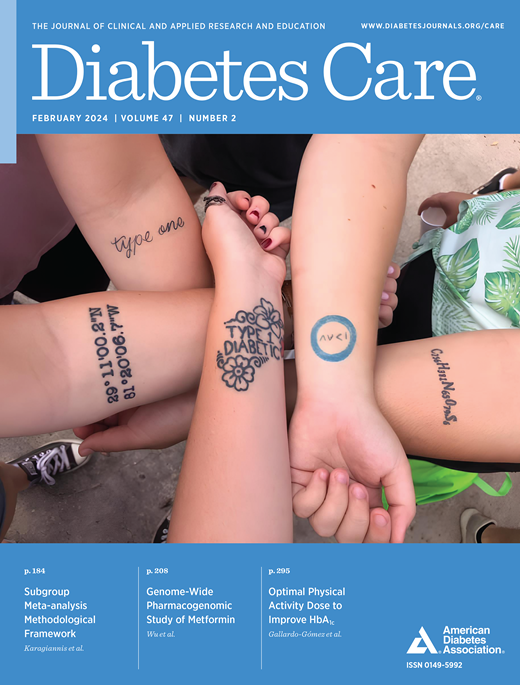高血糖心功能障碍的代谢组学研究——来自社区动脉粥样硬化风险(ARIC)研究和西班牙裔社区健康研究/拉丁裔研究(HCHS/SOL)的发现
IF 16.6
1区 医学
Q1 ENDOCRINOLOGY & METABOLISM
引用次数: 0
摘要
高血糖状态(糖尿病前期和糖尿病)与心力衰竭(HF)风险相关。我们的目的是在高血糖或血糖正常的个体中识别亚临床心功能障碍(HF的前兆)的不同代谢物。研究设计和方法我们对来自社区动脉粥样硬化风险(ARIC)研究访问5,2011 - 2013的2,492名无hf参与者进行了横断面和前瞻性分析。共有1297名参与者为高血糖(根据血红蛋白A1c 5.7%、空腹血糖100mg /dL、使用糖尿病药物或诊断),1195名参与者为血糖正常。我们使用逻辑回归分析了790种代谢物与心功能障碍之间的关系,根据超声心动图异常(左心室肥厚、收缩或舒张功能障碍)或NT-proBNP或肌钙蛋白T升高,分别在两个血糖升高组中定义。在调整临床危险因素后,我们使用Cox回归分析先前步骤中确定的心功能障碍相关代谢物与HF风险之间的前瞻性关联。分析在西班牙裔社区健康研究/拉丁裔研究(HCHS/SOL) (n = 5167)中得到了重复。微血管疾病相关代谢物(如假尿嘧啶、n6 -氨基甲酰苏酰腺苷、n6 -乙酰赖氨酸、N2、n5 -二乙酰鸟氨酸)与高血糖患者心功能障碍相关。碳水化合物和辅因子衍生的代谢物(如gulate,红细胞)与血糖正常者的心功能障碍有关。在两个升糖组中,这些心功能障碍相关代谢物分别与HF风险相关(随访7.5年,137例和94例HF病例,每sd增加的风险比范围分别为1-1.9和1.1-2.9)。HCHS/SOL结果与ARIC结果一致。结论:微血管并发症的代谢物与高血糖患者的心功能障碍相关,但与血糖正常者无关,这支持了微血管功能障碍有助于糖尿病心衰发病的前提。本文章由计算机程序翻译,如有差异,请以英文原文为准。
A Metabolomics Study of Cardiac Dysfunction in Hyperglycemia—Findings From the Atherosclerosis Risk in Communities (ARIC) Study and the Hispanic Community Health Study/Study of Latinos (HCHS/SOL)
OBJECTIVE Hyperglycemic states (prediabetes and diabetes) are associated with heart failure (HF) risk. We aimed to identify distinct metabolites for subclinical cardiac dysfunction, a precursor of HF, in hyperglycemic or euglycemic individuals. RESEARCH DESIGN AND METHODS We conducted cross-sectional and prospective analyses of 2,492 HF-free participants from the Atherosclerosis Risk in Communities (ARIC) study visit 5, 2011–2013. A total of 1,297 participants were hyperglycemic (assessed on the basis of hemoglobin A1c >5.7%, fasting glucose >100 mg/dL, use of diabetes medication, or diagnosis), and 1,195 were euglycemic. We used logistic regression for analysis of association between 790 metabolites and cardiac dysfunction, defined according to echocardiographic abnormalities (left ventricular hypertrophy, systolic or diastolic dysfunction) or elevated NT-proBNP or troponin T, in two glycemic groups separately. We used Cox regression for prospective association between cardiac dysfunction–related metabolites identified in the prior step and HF risk, adjusting for clinical risk factors. Analyses were replicated in the Hispanic Community Health Study/Study of Latinos (HCHS/SOL) (n = 5,167). RESULTS Microvascular disease–related metabolites (e.g., pseudouridine, N6-carbamoylthreonyladenosine, N6-acetyllysine, N2,N5-diacetylornithine) were associated with cardiac dysfunction in hyperglycemic individuals. Carbohydrate and cofactor-derived metabolites (e.g., gulonate, erythrocyte) were associated with cardiac dysfunction in euglycemic individuals. These cardiac dysfunction–related metabolites were prospectively associated with HF risk in the two glycemic groups (follow-up 7.5 years, 137 and 94 HF cases, per-SD increase hazards ratios range 1–1.9 and 1.1–2.9), respectively. HCHS/SOL results were consistent with those from ARIC. CONCLUSIONS Metabolites known for microvascular complications were associated with cardiac dysfunction in hyperglycemic individuals but not among their euglycemic counterparts, supporting the premise that microvascular dysfunction contributes to HF pathogenesis in diabetes.
求助全文
通过发布文献求助,成功后即可免费获取论文全文。
去求助
来源期刊

Diabetes Care
医学-内分泌学与代谢
CiteScore
27.80
自引率
4.90%
发文量
449
审稿时长
1 months
期刊介绍:
The journal's overarching mission can be captured by the simple word "Care," reflecting its commitment to enhancing patient well-being. Diabetes Care aims to support better patient care by addressing the comprehensive needs of healthcare professionals dedicated to managing diabetes.
Diabetes Care serves as a valuable resource for healthcare practitioners, aiming to advance knowledge, foster research, and improve diabetes management. The journal publishes original research across various categories, including Clinical Care, Education, Nutrition, Psychosocial Research, Epidemiology, Health Services Research, Emerging Treatments and Technologies, Pathophysiology, Complications, and Cardiovascular and Metabolic Risk. Additionally, Diabetes Care features ADA statements, consensus reports, review articles, letters to the editor, and health/medical news, appealing to a diverse audience of physicians, researchers, psychologists, educators, and other healthcare professionals.
 求助内容:
求助内容: 应助结果提醒方式:
应助结果提醒方式:


